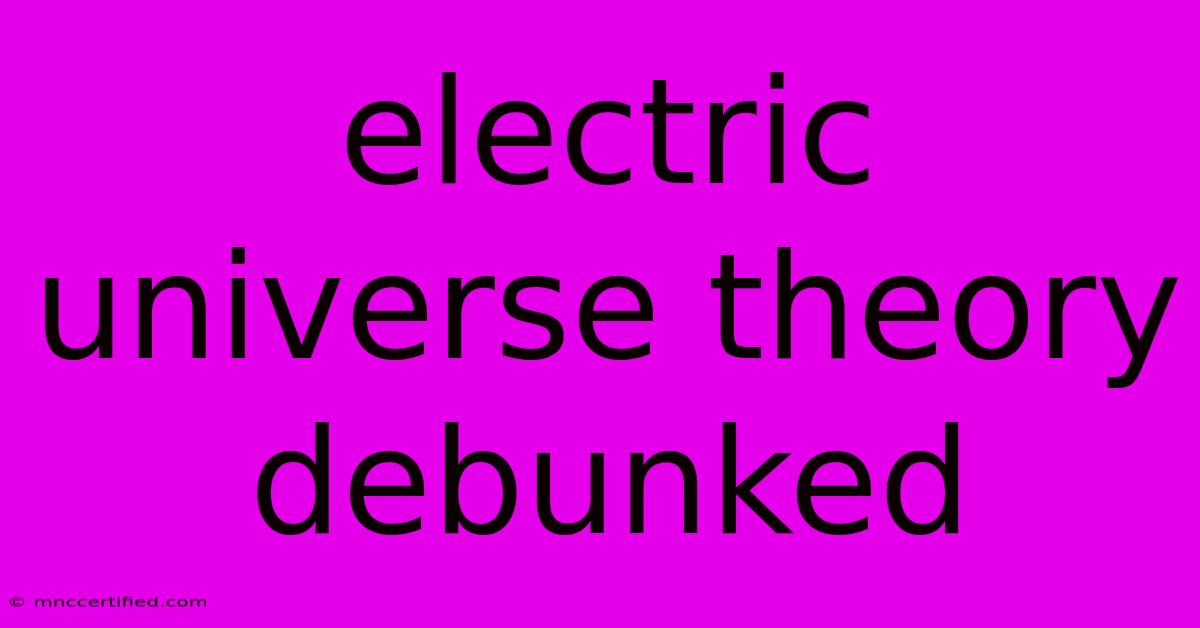Electric Universe Theory Debunked

Table of Contents
Electric Universe Theory Debunked: Why It's Not a Viable Alternative to Mainstream Cosmology
The Electric Universe theory (EU), a fringe model of cosmology, proposes that electric currents and magnetic fields are the primary forces shaping the cosmos, rather than gravity and other fundamental forces as described by mainstream astrophysics. While visually appealing and offering seemingly simple explanations for complex phenomena, the EU theory suffers from a lack of empirical evidence and contradicts well-established scientific principles. This article will delve into the reasons why the Electric Universe theory is widely considered debunked by the scientific community.
Fundamental Flaws in the Electric Universe Theory
The EU theory's central claim that electric currents are the dominant force in space faces several insurmountable challenges:
1. Lack of Observable Evidence:
- Scale of Currents: The EU theory requires astronomically immense electric currents to explain observed celestial phenomena. However, there's no observational evidence for the existence of such currents on the scale required. Detecting these currents would require readily observable effects, none of which have been found.
- Energy Source: The theory lacks a plausible explanation for the immense energy source needed to power these hypothetical currents. Where would this energy come from, and how would it be distributed across such vast distances? The sheer energy requirements are orders of magnitude beyond anything currently understood.
- Plasma Behavior: While the EU theory correctly acknowledges the prevalence of plasma in the universe, its explanation of plasma behavior often oversimplifies the complex physics involved. Mainstream astrophysics has sophisticated models that accurately predict plasma behavior in various astrophysical contexts, something the EU theory struggles to match.
2. Contradiction with Established Physics:
- Gravity's Role: The EU theory downplays or ignores the overwhelming evidence for gravity as the primary force governing the large-scale structure of the universe. Gravitational interactions explain galactic rotation curves, the formation of galaxies and stars, and the expansion of the universe – phenomena the EU theory fails to adequately address.
- Electromagnetic Forces: While electromagnetic forces are undeniably important in some astrophysical processes (like solar flares), their influence is dwarfed by gravity at the cosmological scale. The EU theory exaggerates the role of electromagnetism, assigning it a primary role where it's demonstrably secondary.
- Nuclear Fusion: The EU theory offers alternative explanations for stellar energy production that contradict the well-established understanding of nuclear fusion in stars. Observations of stellar spectra and nucleosynthesis strongly support the fusion model, which is lacking in EU explanations.
3. Failure to Make Falsifiable Predictions:
A hallmark of a good scientific theory is its falsifiability – the ability to be proven wrong through observation or experiment. The EU theory often lacks this crucial element. Many of its claims are vaguely stated or lack specific, testable predictions, making it difficult to evaluate its validity through scientific methods. This ambiguity prevents it from advancing as a legitimate scientific model.
Why the Scientific Community Rejects the Electric Universe
The scientific community's rejection of the EU theory stems not from a closed-mindedness to new ideas, but from the lack of empirical evidence and its incompatibility with established scientific principles. The vast body of observational data in astrophysics strongly supports the standard cosmological model, which successfully explains a wide range of phenomena with remarkable accuracy. The EU theory, by contrast, fails to offer a coherent and testable alternative.
Conclusion: Sticking to Scientific Rigor
The Electric Universe theory, despite its visually compelling imagery, lacks the fundamental rigor and supporting evidence required for acceptance within the scientific community. Its disregard for established physics, its failure to make falsifiable predictions, and its lack of observational support render it an unviable alternative to the well-supported standard cosmological model. While exploring alternative hypotheses is crucial for scientific progress, it must be done within the framework of scientific rigor and evidence-based reasoning. The EU theory, unfortunately, falls far short of this standard.

Thank you for visiting our website wich cover about Electric Universe Theory Debunked. We hope the information provided has been useful to you. Feel free to contact us if you have any questions or need further assistance. See you next time and dont miss to bookmark.
Featured Posts
-
Goffs Nfl Milestone Lions Victory
Nov 18, 2024
-
Raiders Vs Dolphins 2024 Nfl Live
Nov 18, 2024
-
Dean Mc Culloughs Past Itvs Reveal
Nov 18, 2024
-
Updated Snow Warning Alerts
Nov 18, 2024
-
Seahawks Vs 49ers Week 11 Odds
Nov 18, 2024